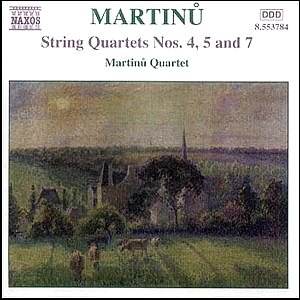Naxos has quietly been doing a
grand job on behalf of the music of Bohuslav Martinů. We
have two volumes of the chamber music, all six symphonies also
his major choral and orchestral work ‘The Epic of Gilgamesh’ and
now the complete string quartets in three volumes. There is an
element of ‘anorakism’ in us all but it’s worth saying
that if you were to buy that lot, the composer’s most significant
compositions, it would set you back only about Ł40.
These three quartets make strange bedfellows.
The 4th is a typically Czech work. I suppose if Janáček
had lived on into the 1930s he might have written a third quartet
like this. The 5th is a very fine and intense
work more in the style of Bartók; dissonant, aggressive
and rhythmic. The 7th is neo-classical and to emphasise
that it has three movements with a central Andante and a final
allegro seeming to update Vivaldi.
But why do composers
write seven or more quartets? Aren’t there enough in the world?
Martinů was very prolific and sometimes one wonders in certain
works if the composer really had anything to say. The 7th
quartet for me is like that. Its twenty-one minutes is stretched
out into ramblings and note spinning without much point ‘signifying
nothing’, unless I’m missing a point somewhere about music of
the neo-classical era. Martinů’s tendency towards
notespinning is especially noticeable in the immediate post-war
period once he had settled into the security of life in New York.
This is, of course, a very personal view.
The other two quartets are fortunately quite
different. They pre-date the time when Martinů
was driven out of his native homeland by the Nazis in 1940. As
such they have more of the earthy Czech quality we associate with
works like ‘In memory of Lidice’, finished in 1943 but started
well before the war, and the Field Mass (1939). These quartets
are each four movement pieces with typically hard-driven scherzos
full of momentum and wonderful singing cross-rhythms. Each has
a lyrical Adagio slow movement.
Czech dances never seem to be far away not only
in the scherzos but, for instance in the first movement of the
4th quartet written in Paris. This also has a typically
contrasting second subject. The fourth movement likewise "draws
on Moravian and Czech sources for its inspiration". I quote
the booklet notes by a writer who has in common with
Martinů the fact that (for Naxos and Marco Polo at least)
he is wonderfully prolific, Keith Anderson. Not only does he succinctly
write about the composer’s life he also gives us analytical notes
that are helpful and not overly academic. Of the 5th
quartet he tells us that: "political circumstances prevented
its performance in 1939 and that it had to wait until 1958 for
its 1st performance". It is the longest and finest
of the three with a substantial finale, which grows from a suspense
laden Lento into a rollicking Allegro. It must have been very
frustrating for the composer to wait almost twenty years before
he could hear it. But surely Martinů
knew Bartók’s 3rd Quartet of 1927.
I have to say that I have not heard these works
before and I therefore feel unable to criticize the performances
and to draw comparisons. However I must warn purchasers that the
recording seems to be rather top heavy. The cello playing of Jitka
Vlasankova may need to be more decisive and clear being here rather
subsumed within the group. I shall blame the recording for this.
The simple expedient of turning up the bass on the amplifier moderates
the effect.
The quartet players are pictured within but why,
again, has Naxos taken over seven years to release this disc?
Gary Higginson
see also review
by Kevin Sutton
